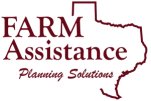In 1997, Texas Cooperative Extension was provided funds from the 75th Texas Legislature to develop a pilot risk management education program to address the increased financial and marketing risk associated with production agriculture in Texas. The region of the pilot program included the Texas Panhandle, South Plains, and Rolling Plains. The following year the initiative effort was expanded to cover the entire state of Texas.
The program, referred to as the Texas Risk Management Education Program (TRMEP), was designed to assist Texas farmers and ranchers in better identifying the sources of risk in their operations, to inform producers of how to use available tools and/or strategies for managing risk, and to help producers quantify the financial impacts of alternative risk management strategies. As a part of TRMEP, the FARM Assistance program was born.
The FARM Assistance team conducted 17 focus group meetings in the pilot areas with groups of producers, lenders, and agribusiness interests. The meetings were held to determine the sources of risk they, or their clientele, face in their operations and what capabilities would enable a computer-assisted decision tool to aid them in making better management decisions.
FARM Assistance is best described as a computerized decision support system. The computer model itself was built on a foundation of 20 plus years of research. Agricultural economists with the Texas A&M University System have developed and perfected methods in risk analysis and in simulating the financial future of an agricultural production firm. Through FARM Assistance, these capabilities have been extended to provide farmers and ranchers in Texas with sound decision-making information.
 FARM Assistance
FARM Assistance